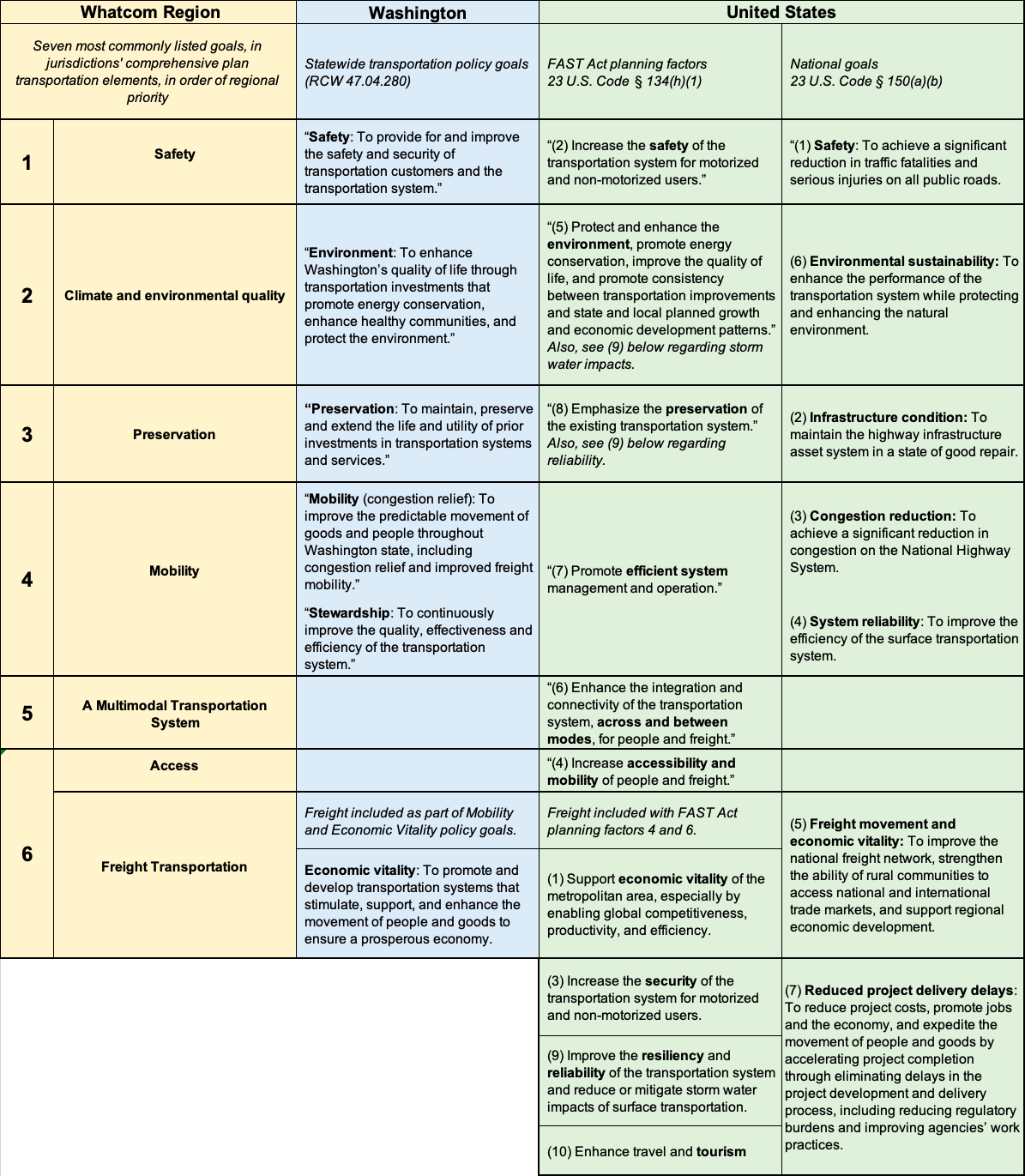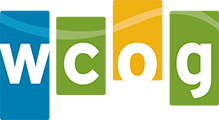To plan for our region’s transportation future, we first need to know what our goals are – what we as a region want to accomplish with the strategies and investments we choose.
Regional goals
Whatcom Mobility 2040 draws on the transportation goals adopted in the comprehensive plans of WCOG’s member jurisdictions: Whatcom County, the seven cities, the Lummi Nation and Nooksack Tribe – in establishing the goals for the Whatcom region. The transportation elements of all the jurisdictions’ comprehensive plans were carefully reviewed, and the goals emphasized in each of them were compiled in a matrix to identify those shared by a majority of the jurisdictions.
Table 11: Whatcom regional transportation goals selected from local transportation plans
Note: The priority list below was amended in October 2020.
| Priority No. | Goal (and number of jurisdictions that established it as a goal in local comprehensive plans) |
| 1 | Safety (10) |
| 2 | Climate & environmental quality (8) |
| 3 | Preservation (6) |
| 4 | Mobility (all modes & emphases on trip capacity) (8) |
| 5 | A multimodal transportation system (8) |
| 6 | Access (6) |
| 6 | Freight transportation (6) |
These seven regional goals – which largely overlap with the more numerous planning factors that federal and state law, respectively, require MPO and RTPO transportation plans to address – will take precedence in prioritizing project funding requests and developing performance measures and targets (see Regional Projects).
Note: Some of the goal descriptions below were slightly revised in October 2020.
Safety
All ten of the Whatcom region’s jurisdictions included safety as one of their transportation goals. The safety of all users of the region’s transportation system – pedestrians, bicyclists, automobile drivers and passengers, and truckers – must be maximized to the greatest degree practicable in the establishment of regional transportation policies and investment decisions.
Climate (greenhouse gas reduction) & environmental quality
Whatcom region local governments, tribal governments, and Washington State government have initiated actions to reduce carbon emissions and prepare for the effects of climate disruption. Reducing greenhouse gas (GHG) emissions and more broadly advancing environmental mitigation and restoration (e.g. energy conservation, habitat preservation, and air and water quality) are outcomes of paramount importance in the region.
Preservation
The high priority of the preservation goal indicates the Whatcom region’s intent to ensure that its existing transportation systems are kept in a state of good repair before pursuing system expansions. This goal includes the principle of sustainability: the importance of choosing investments in facilities and programs that our region has the fiscal capacity to pay for, operate, and maintain into the future.
Mobility
Mobility refers to the summation of qualitative measures of travel and goods movement including travel time, travel-time predictability and reliability, and comfort. The goal of mobility and our region’s strategies to optimize it pertain to all modes (i.e. walking, transit, biking, driving, freight & service trucks, etc.). Mobility depends on adequate transportation system capacity. To advance this mobility goal (and its other goals), the Whatcom region measures capacity primarily as the number of trips that the transportation network can accommodate. Secondarily, traditional, mode specific measures of road-capacity for vehicles are appropriate for certain analyses.
A multi-modal transportation system
To efficiently and equitably serve the movement of people and goods that our region needs in the years ahead, our transportation network must provide multiple types (modes) of transportation (e.g. walking, buses, trucks, cars, bikes, paratransit, rail, etc.) and good connections between them. While the above goal, mobility, addresses the quality of transportation provided by all modes, this goal affirms a commitment to the continued development and integration of the options themselves.
Access
The region’s transportation system is intended to serve all people and acknowledge and reduce barriers related to age (seniors and youth), income, and disability.
Freight transportation
Given Whatcom County’s adjacency to the Canadian border, along with the presence of one of the nation’s premier trade corridors within its boundaries (Interstate 5) and BNSF freight rail, goods movement has a significant impact on the region’s transportation system.
State and national goals
Because of WCOG’s dual responsibilities as both a federally-recognized metropolitan planning organization and as the state-designated regional transportation planning organization for Whatcom County, Whatcom Mobility 2040 must consider and emphasize national and state transportation policy goals, in addition to regionally-adopted goals. The transportation goals of these three levels (regional, state and national) guide the Whatcom region’s ongoing regional transportation planning process and are reflected in the strategies identified in this plan.
A basic requirement of metropolitan transportation plans prepared by MPOs is that they “consider factors described in CFR §450.306 [the federal planning factors] as they relate to a minimum 20-year forecast period.” Additionally, CFR §450.324(f)(2) notes that a plan’s discussion of existing and proposed facilities emphasizes “. . . those facilities that serve important national and regional transportation functions.” A notable recent addition to the original federal planning factors are seven “national goals” introduced as part of the National Goals and Performance Management Measures from the 2012 U.S. transportation funding authorization act known as “Moving Ahead for Progress in the 21st Century,” which are included in the discussion below. In addition to national goals and the Whatcom regional goals discussed in the previous section, the Washington State Legislature has also adopted transportation policy goals.
Aligning regional goals with state and national goals
Among the three levels of government (regional, state, federal) there are four overlapping sets of transportation system goals, all of which are important. Table 12 organizes these four lists so that the state and national goals are grouped into sets that correspond to each of the seven Whatcom regional goals. This approach acknowledges the importance of the state and national goals and planning factors, but places them in a supporting and secondary role to the seven locally-developed Whatcom regional goals. As indicated in the table, the regional goals align neatly with all but five of the 24 state and/or national goals, those being economic vitality, security, resiliency, tourism, and reduction of project delivery delay. It should be noted that WCOG and its member jurisdictions acknowledge the importance of those five state and federal transportation goals that do not align with the Whatcom regional goals, but, unlike the others, they were not consistently mentioned in the transportation plans of Whatcom County’s local jurisdictions, which are the basis of the regional goals in Whatcom Mobility 2040.
Table 12: Relationship of Whatcom Regional Goals to State and National Goals

Applying regional goals to WCOG’s transportation planning process
WCOG is in the early stages of applying Whatcom Mobility 2040’s regional goals to its comprehensive, cooperative and continuing metropolitan and regional transportation planning process, but some initial applications have already begun.
Regional project selection
The Whatcom Transportation Policy Board is responsible for allocating funds from the federal Surface Transportation Block Grant (STBG) and Transportation Alternatives (TA) programs to projects in the Whatcom region. In recent years, approximately $2.7-million in STBG funds and $180,000 in TA funds have been available annually for projects requested by the Policy Board’s member jurisdictions. For a project to be considered, the requesting jurisdiction completes the regional STBG funding application and submits it to WCOG by a prescribed date. All applications are compiled by WCOG so that they can be reviewed and ranked by the Transportation Technical Advisory Group (TTAG) using weighted selection criteria based on the regional goals in Whatcom Mobility 2040. TTAG’s rankings are then considered by the Policy Board when it makes its funding decisions.
Project prioritization in the regional Transportation Improvement Program
Regional STBG and TA program funds are prioritized in the TIP based on the ranking they receive during the review and selection process. All federally-funded projects in the first four years of the TIP must be “fiscally constrained,” i.e., all of the funding needed to complete the project must be identified. Projects programmed in the first year of the TIP are “priority one” projects, projects in the second year are priority two, etc., through the fourth year.
Identifying regional transportation corridors
As discussed in the planning section, WCOG uses the ranked regional goals as a way to support an ongoing discussion among its member jurisdictions and agencies about identifying a set of “regional transportation corridors” that connect population centers within the county (cities, unincorporated hamlets and tribal lands), and then developing operational and investment strategies to maximize the efficiency of those routes.
